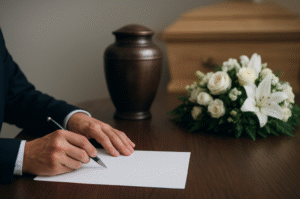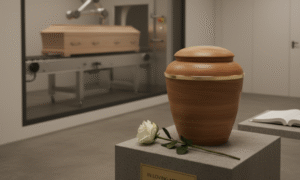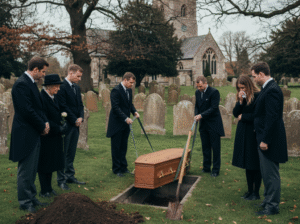Planning a funeral is a deeply emotional task that also comes with practical and legal responsibilities. In the UK, certain steps must be followed by law, while others are personal choices that shape the tone and style of the farewell. A clear checklist can help you navigate each stage and make informed decisions during what can be a difficult time.
1. Register the Death
Legal requirement: In England, Wales, and Northern Ireland, you must register the death within five days; in Scotland, within eight days.
This is done at the local register office for the district where the death occurred. You will need:
- The medical certificate of cause of death.
- Details of the deceased (full name, date of birth, place of birth, occupation, and address).
Once registered, you’ll receive a death certificate. It’s advisable to request multiple copies for legal and financial matters such as closing bank accounts or claiming insurance.
2. Contact a Funeral Director
A funeral director will help coordinate every aspect of the service, from transportation to paperwork. They can:
- Move the deceased into their care.
- Advise on coffins, caskets, burial, or cremation.
- Arrange venues, officiants, and service details.
- Assist with forms such as cremation permits.
Choosing a trusted provider like Gooding Funeral Services ensures that arrangements are handled with professionalism, compassion, and respect for your wishes.
Read more about choosing the right funeral director for your family in the UK.
3. Decide Between Burial and Cremation
This is often influenced by religious or cultural beliefs, personal preferences, or the deceased’s stated wishes.
- Burial: Requires a plot in a cemetery, churchyard, or natural burial ground. Costs vary depending on location and whether it is a private or public grave.
- Cremation: Requires specific forms and medical certification. Ashes can be kept, scattered, or buried.
Some families choose a direct cremation with no service, followed by a separate memorial gathering.
4. Choose a Venue and Date
Common options include:
- Churches or places of worship.
- Crematorium chapels.
- Community halls or private venues.
- Outdoor spaces, where permitted.
When setting a date, consider paperwork timelines, family travel arrangements, and venue availability. Your funeral director can coordinate this on your behalf.
5. Select the Coffin or Casket
Choices range from traditional hardwood designs to modern eco-friendly options such as bamboo, wicker, or cardboard. Factors to consider:
- Suitability for burial or cremation.
- Budget.
- The deceased’s personality or wishes.
Some families choose personalised designs featuring colours, patterns, or engravings.
6. Plan the Service Content
Elements of the service may include:
- Officiant: A minister, celebrant, or family member.
- Music: Hymns, classical pieces, or favourite songs.
- Readings: Scriptures, poems, or personal reflections.
- Eulogies: Spoken tributes that honour the life and character of the deceased.
Discuss with your officiant how long the service will last and whether there will be opportunities for guests to speak.
7. Arrange Flowers, Donations, and Orders of Service
- Flowers: Coffin sprays, wreaths, or seasonal arrangements.
- Donations: Many families request charitable contributions in memory of their loved one.
- Order of Service: A printed booklet outlining the ceremony, music, and readings. This can also serve as a keepsake.
8. Organise Funeral Transport
Traditional options include a hearse for the coffin and limousines for close family. Some families choose alternative vehicles, such as a horse-drawn carriage or classic car, to reflect personal style. Discuss routes and timing with your funeral director.
9. Notify Family, Friends, and the Community
Compile a contact list and decide how to share the funeral details:
- Personal phone calls or messages.
- An obituary in a local newspaper.
- Online funeral notices.
Include the date, time, venue, and any special requests such as dress code or whether flowers are welcome.
10. Plan the Wake or Reception
A wake or reception offers an opportunity for people to gather after the service. This can be:
- At a family home.
- In a community centre or village hall.
- At a pub, hotel, or restaurant.
Food, drink, and informal sharing of memories can make this a comforting way to close the day.
Conclusion
Arranging a funeral service in the UK involves balancing legal responsibilities with meaningful personal touches. By following a clear, step-by-step checklist, you can ensure every detail is addressed and that the service reflects the wishes and personality of your loved one. Gooding Funeral Services is here to guide you through every stage, offering compassionate advice, professional organisation, and a commitment to helping you create a farewell that truly honours your loved one. We serve throughout the UK in cities like Leeds, Manchester, Doncaster, Bradford, Huddersfield and more.
Read more from our guide on funeral services in the UK.
Pages You Might Like:
Funeral directors UK, Funeral services UK, Funeral Services in Leeds, Funeral directors Leeds, Funeral Directors in Bradford, Funeral Directors Bradford, Funeral Directors Manchester, Funeral Directors Huddersfield, Funeral Services in Doncaster, Asian Funeral Services, Hindu Funeral Services, Sikh Funeral Services, Caribbean Funeral Service










